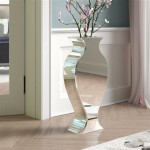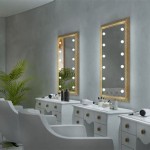How To Tell If You Have a Double-Sided Mirror
A double-sided mirror, also known as a two-way mirror or one-way mirror, is a pane of glass that appears as a mirror from one side and a window from the other. This unique optical effect is achieved through a specific manufacturing process that involves applying a thin, semi-transparent coating of metallic film, typically aluminum, to one side of the glass. This coating reflects a portion of the light that strikes it, creating the mirrored effect. The remaining light is transmitted through the glass, allowing visibility from the other side. The perceived functionality of a double-sided mirror heavily relies on the lighting conditions of the spaces it separates. For the illusion to work effectively, the viewing side needs to be significantly darker than the observed side. This difference in illumination is crucial for the reflected light to dominate on the "mirror" side, obscuring the view through the glass.
Double-sided mirrors are frequently used in various settings where discreet observation is desired. Law enforcement agencies utilize them in interrogation rooms for monitoring suspects. Retail stores employ them to deter shoplifting and observe customer behavior. Psychological research often incorporates them for studying interactions without directly influencing participants. Hotels and fitting rooms have also presented concerns regarding their use, raising privacy issues for guests and customers. Given these potential applications and the inherent privacy concerns, it is important to understand how to identify a double-sided mirror.
The Knuckle Test
The knuckle test is a relatively simple and widely known method for attempting to identify a double-sided mirror. This test relies on the principle that a standard mirror has a layer of reflective material backing the glass. When you touch your knuckle to a regular mirror, there will be a noticeable gap between your knuckle and its reflection due to the thickness of the glass. However, with a double-sided mirror, the reflective coating is applied directly to the surface facing the room. Therefore, when you perform the knuckle test on a double-sided mirror, there will appear to be little to no gap between your knuckle and its reflection.
To perform the knuckle test, place your fingernail against the surface of the mirror. Observe the reflection carefully. If there is a significant gap between your fingernail and its reflection, it is likely a standard mirror. If your fingernail appears to be directly touching its reflection, it could be a double-sided mirror. It is important to note that this test is not foolproof and has limitations. The thickness of the glass can vary, and some modern mirrors are manufactured with thinner glass, reducing the gap even in standard mirrors. Therefore, it is advisable to use this test in conjunction with other methods for a more reliable assessment.
Furthermore, the ambient lighting can affect the accuracy of the knuckle test. A poorly lit room might make it harder to discern the gap between your fingernail and its reflection, potentially leading to a false positive. Therefore, it is optimal to conduct the knuckle test in a well-lit environment to improve the accuracy of the observation.
The Light Test
The light test is another method used to potentially differentiate between a standard mirror and a double-sided mirror. This test involves manipulating the lighting conditions on either side of the mirror to attempt to see through it. As previously mentioned, a double-sided mirror functions effectively when there is a significant difference in lighting between the two spaces it separates. The darker side appears as a mirror, while the brighter side allows observation through the glass.
To perform the light test, turn off the lights in the room where the mirror is located. Then, shine a bright light source, such as a flashlight or your phone's flashlight, directly onto the surface of the mirror. Position yourself close to the mirror while shining the light. Carefully observe the mirror's surface. If it is a double-sided mirror, you might be able to see through it to the other side, even faintly. You might observe shapes, shadows, or even colors from the adjacent room. If it is a standard mirror, you will only see a reflection of the light and your immediate surroundings. The light test is most effective when the room on the other side of the mirror is also well-lit.
The effectiveness of the light test can be influenced by several factors. The intensity of the light source is crucial. A weak light may not be sufficient to penetrate the semi-transparent coating of a double-sided mirror. The ambient light in the adjacent room also plays a role. If the other room is completely dark, it will be much more challenging to see through the mirror, even if it is a double-sided one. The distance between the mirror and your eye is also a factor. Being closer to the mirror improves your chances of detecting any faint images or shadows from the other side. As with the knuckle test, the light test is not definitive and should be used in conjunction with other methods for a more reliable determination.
The Sound Test
The sound test is a method that relies on the principle that a double-sided mirror is essentially a thin pane of glass. The sound test involves tapping on the surface of the mirror and listening to the resulting sound. A standard mirror, with its backing, typically produces a dull, muffled sound when tapped. This is due to the dampening effect of the backing material. A double-sided mirror, lacking this backing, tends to produce a more hollow, resonant sound when tapped.
To perform the sound test, gently tap on the surface of the mirror with your knuckle or a similar object. Listen carefully to the sound produced. Compare the sound to what you would expect from a regular pane of glass. If the sound is dull and flat, it is more likely to be a standard mirror. If the sound is hollow and echoing, it could potentially be a double-sided mirror. Try tapping on different areas of the mirror's surface to see if the sound varies.
Several factors can influence the reliability of the sound test. The size and mounting of the mirror can affect its resonant properties. A large mirror that is securely mounted may produce a less noticeable hollow sound compared to a smaller, loosely mounted one. The material of the wall behind the mirror can also influence the sound. A hollow wall may amplify the echoing effect, potentially leading to a false positive. The ambient noise levels in the room can also make it difficult to accurately hear the sound produced by tapping on the mirror. It is important to perform the sound test in a quiet environment to minimize interference. As with the other tests, the sound test is not definitive and should be used in conjunction with other methods for a more reliable assessment.
Careful Examination and Seeking Professional Assistance
In addition to the previously mentioned tests, a careful visual examination of the mirror and its surroundings can provide clues about its nature. Pay attention to the edges of the mirror. Look for any signs of a seam or gap that might indicate the presence of a double-sided mirror installed within a wall. Examine the surrounding wall for any unusual features, such as hidden cameras or monitoring equipment. Look for any irregularities in the mirror's surface that might suggest it is not a standard mirror.
Consider the context of the location where the mirror is found. If it is in a setting where observation is common, such as an interrogation room or a retail store's security area, the likelihood of it being a double-sided mirror increases. If you have strong suspicions about a mirror and are concerned about privacy violations, it is advisable to seek professional assistance. A qualified professional, such as a private investigator or a security expert, can conduct a thorough inspection of the mirror and its surroundings, using specialized equipment to determine its true nature definitively. They can also advise you on appropriate actions to take if you discover a double-sided mirror in an inappropriate setting.
Ultimately, determining whether a mirror is double-sided can be challenging and relies on a combination of observational techniques and circumstantial evidence. No single test is foolproof, and it is best to employ multiple methods for a more comprehensive assessment. When in doubt, seeking professional help is always the most prudent course of action, particularly if you have concerns about privacy violations.
I M In A Room With Mirror On One Wall How Can Tell If It Is 2 Way Someone Watching Me The Other Side Quora

How To Tell If A Mirror Is Two Way Or Not Quora

How To Tell If A Mirror Is Two Way Or Not 8 Steps With Pictures

How To Detect A Two Way Mirror Fingernail Test

How To Tell If You Re In A Room Restroom Motel Etc With Mirror Or

How To Tell If A Mirror Is Two Way Or Not 8 Steps With Pictures
Is It Glass Or A Two Way Mirror The Balancing Act

Tips For Identifying Whether Your Mirror Is Two Way Or Not Ledmyplace
How To Tell If A Mirror Is Two Way Or Not Quora

How To Tell If A Mirror Is Two Way Or Not 8 Steps With Pictures








